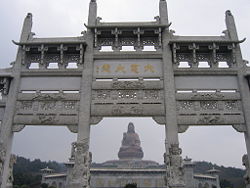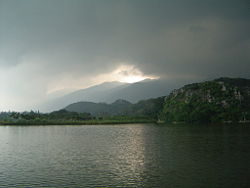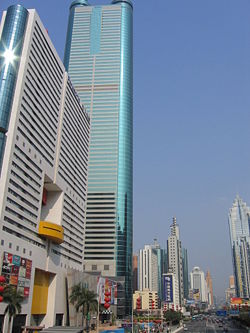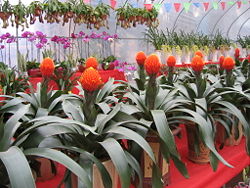Guangdong
- Not to be confused with the former Kwantung Leased Territory in north-eastern China.
| 广东省 Guǎngdōng Shěng | |
| Abbreviations: simplified Chinese: 粤; traditional Chinese: 粵 (Pinyin: Yuè, Jyutping: Jyut6, Yale: Yuht) | |
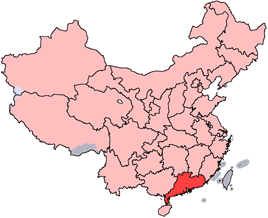
| |
| Origin of name | 广 guǎng - "Wide" 东 dōng- "East" Lit. "The Eastern Expanse" |
| Administration type | Province |
| Capital (and largest city) |
Guangzhou |
| CPC Ctte Secretary | Wang Yang |
| Governor | Zhu Xiaodan |
| Area | 177900 km² (15th) |
| Population (2010) - Density |
104,303,132 (1st) 536/km² (7th) |
| GDP (2011) - per capita |
CNY 5.30 trillion US$ 838.60 billion[1] (1st) CNY 50,295 US$ 7,787 (8th) |
| HDI (2008) | 0.844 (high) (4th) |
| Major nationalities | Han - 99% Zhuang - 0.7% Yao - 0.2% |
| Prefecture-level | 21 divisions |
| County-level | 121 divisions |
| Township-level† | 1642 divisions |
| ISO 3166-2 | CN-44 |
| Official website http://www.gd.gov.cn (Simplified Chinese characters) | |
Guangdong (formerly spelled "Kwangtung") is a province on the southern coast of the People's Republic of China. It is bordered to the west by Guangxi, to the northwest by Hunan, to the northeast by Jiangxi, and to the east by Fujian. In addition, the island of Hong Kong is located directly below the province, and the island province of Hainan is located further southwest, a short distance away in the South China Sea.
Guangdong, located remote from the centers of power in Chinese civilization, enjoyed a measure of independence that attracted European colonialists and bred Chinese revolutionaries. Prior to the modernization program inaugurated with the "rich is beautiful" movement in China during the early 1990s, Guangdong catapulted into the number one economy among the China provinces. The birth place of the Republic of China, along with its proximity to the economic powerhouse Hong Kong, places Guangdong in an excellent position to lead the democratization and free enterprise movement sweeping across China.
Overview
"Guang" itself means "expanse" or "vast," and has been associated with the region since the creation of Guang prefecture in 226. "Guangdong" and neighboring Guangxi literally mean "expanse east" and "expanse west," so together both Guangdong and Guangxi are known as the "Dual-Guangs" (兩廣 liăng guăng) or "Dual-expanses." Sometimes, the name "Canton province" (based on a French-derived transliteration of "Guangdong") is used to describe the region, and hence, the local people and their language is referred to as Cantonese. This name is different from "Canton (City)," which refers to the provincial capital city of Guangzhou.
Guangdong is well-known historically as the homeland and base of operations of Sun Yat-Sen, the widely accepted founder of modern China. Additionally, it is the homeland for the majority of the overseas Chinese population, many of whom settle in parts of the Western world.[2].
Guangdong has also become the subject of some controversy in recent years due to its disputed title as the most populous province in China. Although Henan has officially been given this distinction, the large population of undocumented migrant workers living in Guangdong inflate its population numbers well above the 100 million mark, making Guangdong the most populous province in the country according to figures from January 2005.[3][4]
History
Guangdong was far away from the center of ancient Chinese civilization, which developed largely in the North China Plain. It was populated mostly by peoples collectively known as the Hundred Yue, who may have been Tai-Kadai and related to the Zhuang people who currently live in modern Guangxi province.
Chinese administration in the region began with the Qin Dynasty, which, after establishing the first unified Chinese empire, expanded southwards and set up Nanhai Commandery at Panyu, near what is now part of Guangzhou. The area, which was known as Nanyue, was independent between the fall of the Qin dynasty and the reign of Emperor Wu of Han. It was the administered by the Han Dynasty, who also controlled Guangxi and northern Vietnam collectively as Jiao Province. Under the Wu Kingdom of the Three Kingdoms period, Guangdong was made into its own province, the Guang Province, in 226.
As time passed, the demographic make up of what is now Guangdong shifted towards Han Chinese dominance, especially because of the several periods of massive migration from the north that occured mostly during periods of political turmoil and/or nomadic incursions from the fall of the Han Dynasty onwards. For example, internal strife in northern China following the rebellion of An Lushan resulted in a 75 percent increase in the population of Guangzhou prefecture in the eighth and early ninth centuries. As more migrants entered Guangdong, the local population began assimilating to Han Chinese culture, or in many cases were simply displaced. [5]
Together with Guangxi, Guangdong was made part of the Lingnan circuit, (or literally "Mountain-South" circuit) in 627 during the Tang Dynasty. The Guangdong part of Lingnan circuit was renamed Guangnan east circuit in 971 during the Song Dynasty (960 - 1279). This designation of "Guangnan East" serves as the source for the current name "Guangdong."
As Mongols from the north engaged in their conquest of China in the thirteenth century, the Southern Song Dynasty retreated southwards, eventually ending up in modern day Guangdong. The Battle of Yamen (1279) in Guangdong marked the end of the Southern Song Dynasty (960 - 1279).
During the Mongol Yuan Dynasty, Guangdong was made a part of Jiangxi. Its present name, "Guangdong Province" was given during the early part of the Ming Dynasty.
Since the sixteenth century, Guangdong has had extensive trade links with the rest of the world. European merchants coming northwards via the Straits of Malacca and the South China Sea, particularly the Portuguese and British, traded extensively through Guangzhou. Macau, on the southern coast of Guangdong, was the first European settlement in China, and was established in 1557. It was the opium trade through Guangzhou that initially triggered the Opium Wars, opening an era of foreign incursion and intervention throughout China. In addition to Macau, which was then a Portuguese colony, Hong Kong was ceded to the British, and Kwang-Chou-Wan to the French. In the nineteenth century, Guangdong was also the major port of exit for laborers traveling to southeast Asia, the Western United States, and Canada.
Historically, many overseas Chinese communities have their origins in Guangdong and specifically Taishan. Together, Cantonese and Taishanese (the local dialect of Taishan, spoken by less than 10 percent of Chinese people in China), continue to have more speakers among the overseas Chinese than it does in proportion to the number of speakers in mainland China.
During the 1850s, the first revolt of the Taiping Rebellion led by the Hakka people took place in Guangdong. Because of direct contact with the West, Guangdong was the center of anti-Manchu and anti-imperialist activity. The founder of modern China, Sun Yat-Sen, was originally from Guangdong, and he established the Republic of China in 1912.
During the early 1920s under the Republic of China, Guangdong was the staging area for the Kuomintang (KMT) to prepare for the Northern Expedition, which was an effort to bring the various warlords of China back under the control of the central government. Whampoa Military Academy was built near Guangzhou, to help train military commanders during this period and even later on.
In recent years, the province has seen extremely rapid economic growth, aided in part by its close trading links with Hong Kong, which borders it. As a result of this tremendous growth, Guangdong is now the province with the highest gross domestic product in all of China. It also contributes approximately 12 percent of the entire national economic output.
Hainan island was originally part of Guangdong, but it was separated into its own province in 1988.
Geography
Guangdong faces the South China Sea to the south and has a total of 4,300 km of coastline. Leizhou Peninsula is on the southwestern end of the province, and is home to a few inactive volcanoes.
The province is geographically separated from the rest of northern China by a few mountain ranges collectively called the Southern Mountain Range (南岭). The highest point in the province is about 1,600 meters above sea level.
The Pearl River Delta is the convergent point of three upstream rivers: the Dongjiang River, the Beijiang River, and the Xijiang River, and the delta is also filled with hundreds of small islands.
Guangdong has a humid subtropical climate (tropical in the far south), with short, mild, dry, winters and long, hot, wet summers. Average daily highs in Guangzhou in January and July are 18C (64F) and 33C (91F) respectively, although the humidity makes it feel much hotter in summer. Frost is rare on the coast but may happen a few days each winter well inland.
Major cities include:
Major rivers and lakes:
- Dongjiang River
- Xijiang River
- Beijiang River
Administrative divisions
The current immediate administrative divisions of Guangdong consist of 21 prefecture-level cities:
- Chaozhou (潮州) (Teochew)
- Dongguan (东莞) (Donggoon)
- Foshan (佛山) (Futsaan)
- Guangzhou sub-provincial city (广州) (Canton)
- Heyuan (河源) (Hoyun)
- Huizhou (惠州) (Waizao)
- Jiangmen (江门) (Gongmoon)
- Jieyang (揭阳) (Keetyeung)
- Maoming (茂名) (Mohming)
- Meizhou (梅州) (Muizao)
- Qingyuan (清远) (Tsingyun)
- Shantou (汕头) (Swatow)
- Shanwei (汕尾) (Seenmei)
- Shaoguan (韶关) (Seeoogoon)
- Shenzhen sub-provincial city (深圳) (Sumzun)
- Yangjiang (阳江) (Yeunggong)
- Yunfu (云浮) (Wunfao)
- Zhanjiang (湛江) (Sumgong)
- Zhaoqing (肇庆)
- Zhongshan (中山) (Zhongsan)
- Zhuhai (珠海) (Zuhoi)
The 21 prefecture-level divisions are further subdivided into 121 county-level divisions (54 districts, 23 county-level cities, 41 counties, and three autonomous counties). Those are in turn divided into 1585 township-level divisions (1145 towns, four townships, seven ethnic townships, and 429 subdistricts).
Economy
After the communist takeover and up until the start of the Deng Xiaoping reforms in 1978, Guangdong was an economic backwater, although a large underground, service-based economy has always existed. Economic development policies encouraged industrial development in the interior provinces, which were weakly linked to Guangdong via existing transportation links. The government's policy of economic autarchy made Guangdong's access to the ocean irrelevant, because all of the economic development was taking place within the interior.
Deng Xiaoping's open-door economic policy radically changed the economy of the province, as it enabled it to take advantage of its access to the ocean, proximity to Hong Kong, and historical link to the overseas Chinese population. In addition, until the 1990s, when the Chinese taxation system was reformed, the province benefited from the relatively low rate of taxation placed on it by the central government due to its historical status of being economically backward.
Although Shanghai is often cited as evidence of China's success, Guangdong's economic boom exemplifies the reality of the vast labor-intensive manufacturing powerhouse China has become, and all the rewards and shortcomings that come with it. Guangdong's economic boom began in the early 1990s and has since spread to neighboring provinces, while also pulling their populations inward.
In terms of agriculture, rice is the leading crop in the province, occupying roughly 76 percent of the total cultivated area and accounting for over 80 percent of Guangdong's total food production. Besides rice, the other main crops are fruits and vegetables. Among the 200 varieties of fruit grown in Guangdong are pineapples, bananas, lychees, longans, and oranges.
In addition to agriculture, the province also utilizes its access to the sea through an extensive network of interconnected waterways that houses numerous reservoirs and fish ponds. Guangdong's marine breeding areas cover 780,000 hectares and it also has 430,000 additional hectares of freshwater breeding areas.
Besides agriculture and marine products, the provincial economy is largely based on its light and heavy industries. Apart from handicrafts, some of Guangdong's light industry includes food processing, textiles, sugar refining, silk filature, (the reeling of silk from cocoons) and weaving. Guangdong's heavy industry sectors include mining, metal processing, machinery, shipbuilding and ship repair, and the production of hydroelectricity.
Guangdong is now one of the richest provinces in the nation, with the highest GDP among all the provinces. However, wage growth has only recently begun to rise, due to a large influx of migrant workers from neighboring provinces. Its nominal GDP for 2005 was 2.17 trillion yuan (US$267.6 billion), a rise of 12.5 percent on a year-to-year basis and is expected to reach 2.58 trillion yuan (US$329.67 billion) by the end of 2006, a rise of 14 percent from 2005. Guangdong's primary, secondary, and tertiary industries were worth 137.46 billion yuan, 1.08 trillion yuan, and 957.94 billion yuan respectively.[6]
Currently, Guangdong is also home to three of the six Special Economic Zones in China: Shenzhen, Shantou and Zhuhai. While the increased affluence of Guangdong has been a remarkable story, the wealth has not been distributed evenly across the entire province, and still remains very much concentrated near the Pearl River Delta. Like in other parts of China, the rural inland areas in Guangdong have not benefited as strongly from the economic boom of the past few decades, and the disparity between the rich and poor throughout the province has increased, following a nation-wide trend.
Demographics
Guangdong became the most populous province in January 2005, [7][8] however, official statistics had traditionally placed Guangdong as the fourth most populous province of China, with about 80 million people. Recently released information suggests that there are an additional 30 million migrants who reside in Guangdong for at least six months every year, making it the most populous province with a population of more than 110 million. The massive influx of migrants from other provinces, dubbed the "floating population," is due to Guangdong's booming economy and high demand for labor.
Guangdong is also the ancestral home of large numbers of overseas Chinese. Most of the railroad laborers in Canada, the Western United States, and Panama in the nineteenth century came from Guangdong. Emigration in recent years has slowed with economic prosperity, but the province is still a major source of immigrants for North America and for many other parts of the world.
The majority of the province's population is Han Chinese, although there is a small Yao population in the north. Other minority groups include the Miao, the Li, and the Zhuang peoples.
Because of the high population density and the close proximity in which humans and animals live, Guangdong has often been the source of respiratory diseases such as influenza. In late 2002, Guangdong was suspected as the initial source of SARS.
Education
According to statistics taken at the end of 2000, there were 52 higher education institutions in Guangdong, with a total of 299,500 students and 46,800 teachers. Along with this there were 3,964 regular secondary schools, with 4,606,900 students and 228,600 teachers, and 24,200 primary schools, with 9,299,300 students and 364,100 teachers. The school-age student enrollment rate was 99.70 percent, and of the primary school graduates, 96.35 percent entered into junior high schools.
Colleges and universities
- Foshan University (Guangzhou, Foshan)
- Jinan University (Guangzhou, Zhuhai, Shenzhen)
- Shantou University (Shantou)
- South China University of Technology (Guangzhou)
- Sun Yat-sen University (Guangzhou, Zhuhai)
- Shenzhen University (Shenzhen)
- South China Normal University (Guangzhou)
- Dongguan University of Technology (Dongguan)
- Shunde University (Shunde)
- South China Agricultural University (Guangzhou)
Culture
Guangdong is a multicultural province. The central region, which is also the political and economic center, is populated predominantly by Cantonese-speakers. This region is associated with Cantonese cuisine, (simplified Chinese: 粤菜; traditional Chinese: 粵菜) and although it has the name Cantonese (simplified Chinese: 粤; traditional Chinese: 粵), Cantonese cuisine also includes Hakka cuisine (simplified and traditional Chinese: 客家菜) and Teochew cuisine (simplified and traditional Chinese: 潮州菜). The SARS virus is thought to have originated in Guangdong, due to the cuisine of the region, which famously includes "anything that walks, crawls or flies."
Cantonese opera (simplified Chinese: 粤剧; traditional Chinese: 粵劇) is a form of Chinese opera popular in Guangdong and other Cantonese speaking areas.
The Hakka people live in large areas of Guangdong, including Huizhou, Meizhou, Shenzhen, Heyuan, Shaoguan and other areas. Most of the Eastern part of Guangdong is populated by the Hakka people, except for the Chaozhou and Hailufeng area. Hakka culture includes Hakka cuisine (客家菜), Han opera (simplified Chinese: 汉剧; traditional Chinese: 汉劇), Hakka Hanyue and sixian (traditional instrumental music) and Hakka folk songs (客家山歌).
The area around the cities of Chaozhou and Shantou in eastern Guangdong, forms its own cultural sphere. Here, the people speak Teochew (simplified Chinese: 潮语, traditional Chinese: 潮語), and their cuisine is Chiuchow cuisine. The Teochew people, the people in Hailufeng and the people in Leizhou Peninsula all speak a language similar to Min. Teochew opera (simplified Chinese: 潮剧, traditional Chinese: 潮劇) is also very famous and has a unique form.
In addition to the various local varieties of spoken Chinese, most people in Guangdong also speak Mandarin, the national language of the PRC.
Notable attractions in Guangdong include Danxia Mountain, Yuexiu Hill in Guangzhou, Star Lake, the Seven Star Crags, and Dinghu Mountain.
Guangdong is served by several Guangdong Radio stations and Guangdong TV. There is also an international station Radio Guangdong which broadcasts information about this region to the entire world through the World Radio Network.
Professional sports teams based in Guangdong include:
- Chinese Basketball Association
- Guangdong Hongyuan Southern Tigers
- Chinese Football Association Jia League
- Guangzhou Rizhiquan
- Chinese Football Association Super League
- Shenzhen Jianlibao
Gallery
Notes
- ↑ China’s Provincial GDP Figures in 2011 | China Briefing News. China-briefing.com (January 27, 2012). Retrieved June 28, 2012.
- ↑ OCLC [1]Languages of China. oclc.org. Retrieved January 18, 2008.
- ↑ Peoples Daily online English people.com.cn, January 30, 2005.Retrieved January 18, 2008.
- ↑ China DailyChinadaily.com .Retrieved January 18, 2008.
- ↑ PubMedCentral pubmedcentral.nih.gov.Retrieved January 19, 2008.
- ↑ "News.xinhuanet.com02-06-2004">News.xinhuanet.com 02-04-2006.
- ↑ People's Daily onlineEnglish people.com.cnGuangdong becomes most populous province.
- ↑ Chinadaily.com .Retrieved January 19, 2008.
ReferencesISBN links support NWE through referral fees
- Bui, Tung X. China's economic powerhouse reform in Guangdong Province. New York: Palgrave Macmillan, 2003. ISBN 978-1403903853
- Loh, Christine. Energy supply and fuels supply in Guangdong impact on air quality in Hong Kong and Guangdong. Hong Kong: Civic Exchange, 2006. OCLC 68985432
- Vogel, Ezra F. One step ahead in China Guangdong under reform. Cambridge, Mass: Harvard University Press, 1989. ISBN 978-0674639102
External links
All links retrieved June 20, 2024.
| Province-level divisions administered by the People's Republic of China (PRC) | |
|---|---|
| Provinces | Anhui · Fujian · Gansu · Guangdong · Guizhou · Hainan · Hebei · Heilongjiang · Henan · Hubei · Hunan · Jiangsu · Jiangxi · Jilin · Liaoning · Qinghai · Shaanxi · Shandong · Shanxi · Sichuan · Taiwan · Yunnan · Zhejiang |
| Autonomous regions | Guangxi · Inner Mongolia · Ningxia · Tibet (Xizang) · Xinjiang |
| Municipalities | Beijing · Chongqing · Shanghai · Tianjin |
| Special administrative regions | Hong Kong · Macau |
Prefecture-level divisions of Guangdong
|
Credits
New World Encyclopedia writers and editors rewrote and completed the Wikipedia article in accordance with New World Encyclopedia standards. This article abides by terms of the Creative Commons CC-by-sa 3.0 License (CC-by-sa), which may be used and disseminated with proper attribution. Credit is due under the terms of this license that can reference both the New World Encyclopedia contributors and the selfless volunteer contributors of the Wikimedia Foundation. To cite this article click here for a list of acceptable citing formats.The history of earlier contributions by wikipedians is accessible to researchers here:
The history of this article since it was imported to New World Encyclopedia:
Note: Some restrictions may apply to use of individual images which are separately licensed.
